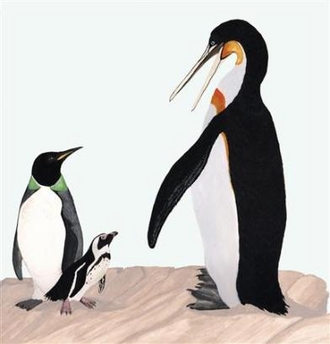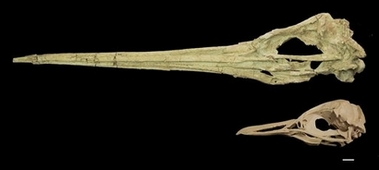Ancient penguins waddled, swam in warm locales
By Will Dunham Mon Jun 25, 8:55 PM ET
WASHINGTON (Reuters) – Penguins were waddling and swimming in warm locales tens of millions of years earlier than previously thought, according to scientists who described on Monday fossils of two previously unknown types found in Peru.
One of the two, named Icadyptes salasi, lived about 36 million years ago, possessed a long, spear-like beak, and stood 5 feet tall.
“This one had a beak you had to reckon with,” North Carolina State University paleontologist Julia Clarke, who led the research, said in a telephone interview.
It was bigger than any penguin alive today and the third-largest penguin known to have lived, Clarke said.
The earliest known fossil of these aquatic flightless birds, found in New Zealand, dates to about 61 million years ago, not long after the extinction of the dinosaurs and many other life forms 65 million years ago.
The largest penguin around today is the Emperor Penguin, which stands almost 4 feet tall.
The second newly discovered species was smaller and slightly older than Icadyptes.
Perudyptes devriesi lived about 42 million years ago and was about the size of today’s King Penguin, about 2-1/2 to 3 feet tall. It is thought to represent an early part of penguin evolutionary history.
Both of these ancient penguins lived on Peru’s southern coast and were found relatively close to one another in a coastal Peruvian desert in 2005. Penguins still live on Peru’s coast.
These remains are among the most complete ever found of extinct penguins and throw into doubt existing notions about the timing and pattern of penguin evolution and expansion.
Many scientists had believed that penguins did not leave cold-weather regions like Antarctica and New Zealand for warmer, more equatorial regions until perhaps 4 million to 8 million years ago, but these two newly discovered species indicate this took place tens of millions of years earlier.
Penguins, denizens of the Southern Hemisphere, populate cold climates such as Antarctica, but also inhabit warmer regions closer to the Equator like the Galapagos Islands.
They are beautifully adapted to life in the ocean, with wings that have evolved into flippers, allowing them to swim gracefully through the water, catching fish, squid and other food.
The research, which also included scientists from Peru and Argentina, was published in the journal Proceedings of the National Academy of Sciences.

This illustration shows two newly discovered extinct penguins, both found in Peru, along with an existing Peruvian penguin. On the right is Icadyptes salasi, which lived about 36 million years ago and stood five feet (1.5 meters) tall. It was bigger than any penguin alive today and the third largest penguin known to have lived. On the left is Perudyptes devriesi, which lived about 42 million years ago, was about 2-1/2 to 3 feet tall (0.76 to 0.91 meters). In the middle is the only penguin inhabiting Peru today, Spheniscus humbolti. The research was published in the Proceedings of the National Academy of Sciences. (KristinLamm/Handout/Reuters)

This undated handout photo provided by the Proceedings of the National Academy of Sciences (PNAS) shows two fossils recently discovered in Peru reveal that early penguins responded differently to natural climate change than scientists would have predicted. The smaller of the two, Perudyptes devriesi, was comparable in size to the living king penguin. The larger, Icadyptes salasi, would have been fearsome to encounter at over five feet tall, with a seven-inch beak, and is one of the largest penguins ever described. (AP Photo, PNAS, Daniel Ksepka)
These penguins don’t march, they stomp!






